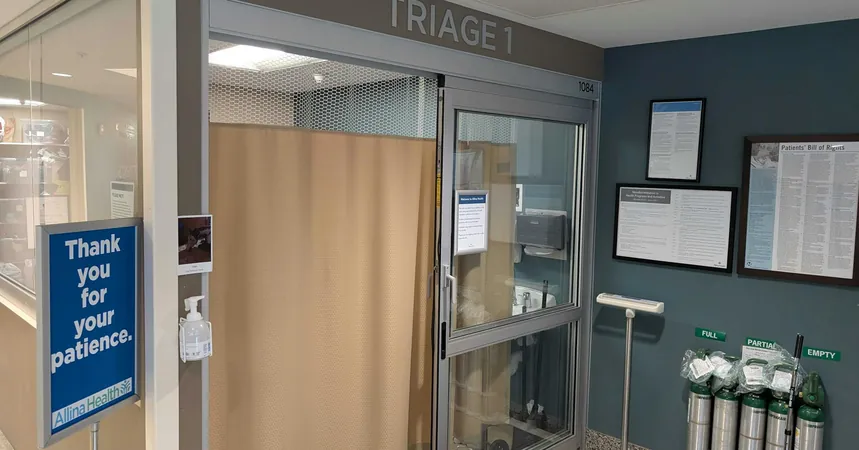
Minnesota Hospitals Overwhelmed as Flu Cases Surge: Are We Prepared for the Crisis?
2025-01-16
Author: Ying
Minnesota Hospitals Overwhelmed as Flu Cases Surge: Are We Prepared for the Crisis?
As Minnesota grapples with an alarming surge in flu cases and other viral illnesses, emergency rooms are struggling to cope with the influx of patients. Hospitals across the state have reverted to triage systems, originally developed during the height of the COVID-19 pandemic, to manage the situation.
Last month, United Hospital in St. Paul unveiled its "split flow" model, which enables patients to receive initial care while waiting in the emergency room (ER) lobby when capacity is exceeded. On a recent Thursday, over 20 patients occupied the waiting area, many of whom were already receiving essential care such as IV fluids and blood tests. Remarkably, this approach has allowed patients to see healthcare providers more promptly than before, even amid the highest patient volumes recorded in the last month, according to Dr. Kelsey Echols, the medical director at United's ER.
The flu-related hospitalizations skyrocketed to 877 during the first week of January but showed a slight decline to 742 by January 11. This current number, however, still exceeds statistics from previous flu seasons, complicating matters for hospitals that are also addressing COVID-19, respiratory syncytial virus (RSV), and norovirus cases.
In light of this crisis, Dr. Will Nicholson from M Health Fairview's East Metro Hospitals emphasizes the importance of vaccinations, self-care, and adherence to health guidelines to curb illness spread. He remarked, "Take care of yourself, folks," urging citizens to avoid crowded places if unwell.
Several healthcare systems, including Fairview and Allina Health, have adopted the triage model across multiple facilities, anticipating a surge of sick patients. Despite the full capacity in some ER bays, the wait time for incoming patients was reduced to approximately 50 minutes due to the triage care approach. Meanwhile, critically ill patients were still prioritized, maintaining zero wait times for trauma cases.
A case in point is Dave Peterson, 72, who arrived at United ER concerned about potential stroke symptoms. Although he waited almost five hours to be taken into an ER room, receiving care in a triage setting allowed for expedited testing that confirmed a mild stroke due to a blood clot.
The situation is further complicated by recent flu outbreaks in long-term care facilities across Minnesota, rising from eight to 14 last week. Such outbreaks often lead to staff shortages, limiting the number of patients nursing homes can admit from hospitals and consequently prolonging the stay of patients needing inpatient care, which exacerbates emergency room congestion.
Nicholson acknowledged that although triage strategies are beneficial, the smaller size and limited waiting area of facilities like St. John’s Hospital poses ongoing challenges. In the past, patients had to wait outside in vestibules during peak periods, prompting hospital renovations to enhance triage capabilities and short-stay units for observation.
As the population ages and more complex medical cases arise, hospitals face a persistent challenge. The ongoing boardings in emergency departments are a clear indication of systemic pressures that must be addressed.
While COVID-19 continues to place strain on Minnesota’s healthcare system, it has caused fewer hospitalizations compared to last year. However, since October, over 230 deaths related to COVID-19 have been reported, primarily among seniors. Influenza has also claimed 50 lives in the same timeframe, highlighting the ongoing dangers these viruses pose to the population.
With flu season well underway and indications of COVID-19 levels stabilizing, the need for proactive health measures and effective hospital management is clearer than ever. Will Minnesota's healthcare system be ready to face the challenges ahead? Only time will tell, but the current situation urges vigilance and community collaboration to prevent further escalation.



 Brasil (PT)
Brasil (PT)
 Canada (EN)
Canada (EN)
 Chile (ES)
Chile (ES)
 Česko (CS)
Česko (CS)
 대한민국 (KO)
대한민국 (KO)
 España (ES)
España (ES)
 France (FR)
France (FR)
 Hong Kong (EN)
Hong Kong (EN)
 Italia (IT)
Italia (IT)
 日本 (JA)
日本 (JA)
 Magyarország (HU)
Magyarország (HU)
 Norge (NO)
Norge (NO)
 Polska (PL)
Polska (PL)
 Schweiz (DE)
Schweiz (DE)
 Singapore (EN)
Singapore (EN)
 Sverige (SV)
Sverige (SV)
 Suomi (FI)
Suomi (FI)
 Türkiye (TR)
Türkiye (TR)
 الإمارات العربية المتحدة (AR)
الإمارات العربية المتحدة (AR)